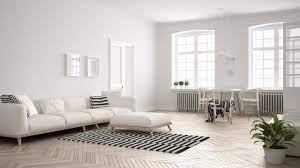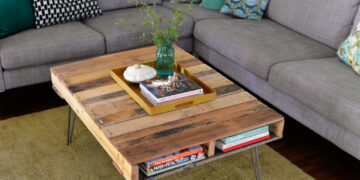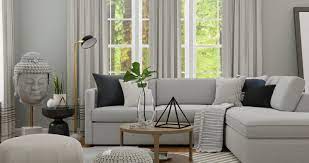Minimalism is a design philosophy that emphasizes simplicity, functionality, and the use of minimal elements. This approach has profoundly impacted furniture design and style, leading to a shift away from ornate and highly decorative pieces towards simpler, more functional designs. In this article, we will explore the impact of minimalism on furniture design and style, and how it has influenced the way we view and use furniture.
The Origins of Minimalism in Furniture Design
Minimalism as a design philosophy emerged in the 1960s, as a reaction to the excesses of the previous decade. The modernist movement, which dominated design in the 1950s, had focused on creating highly decorative and complex pieces that often prioritized form over function. In contrast, minimalism sought to strip design down to its essentials, emphasizing simplicity, functionality, and practicality.

This new approach to design was reflected in furniture as well. Minimalist furniture was characterized by its clean lines, simple shapes, and lack of ornamentation. Pieces were often made from industrial materials, such as steel and glass, and were designed to be practical and functional, rather than decorative.
One of the pioneers of minimalist furniture design was the German architect and designer Ludwig Mies van der Rohe. Mies van der Rohe was famous for his maxim “less is more”, which encapsulated the minimalist ethos of simplicity and elegance. He designed several iconic pieces, such as the Barcelona chair, which were celebrated for their clean lines and minimalist aesthetic.
The Impact of Minimalism on Furniture Design and Style
The impact of minimalism on furniture design and style has been significant. By emphasizing simplicity and functionality, minimalist furniture has helped to democratize design, making it more accessible to a wider range of people. Rather than being the preserve of the wealthy elite, minimalist furniture has become popular among a broad range of consumers who appreciate its understated elegance and practicality.
One of the key ways in which minimalism has influenced furniture design and style is through the use of materials. Minimalist designers often favor industrial materials, such as steel and glass, which are strong, durable, and functional. These materials are also easy to mass-produce, which has helped to make minimalist furniture more affordable and accessible.
Minimalist furniture is also characterized by its simple shapes and clean lines. Rather than relying on ornate decorations or intricate details, minimalist pieces are designed to be visually simple and unobtrusive. This focus on simplicity has helped to make minimalist furniture versatile and adaptable, allowing it to fit into a wide range of interior design styles and environments.
Another way in which minimalism has influenced furniture design and style is through the use of color. Minimalist furniture is often characterized by a limited palette of colors, with white, black, and neutral tones being popular choices. This use of color helps to create a sense of calm and tranquility, which is in keeping with the minimalist ethos of simplicity and elegance.
The Benefits of Minimalist Furniture Design
There are several benefits to minimalist furniture design. One of the key advantages is its practicality and functionality. Minimalist furniture is designed to be simple and unobtrusive, which makes it ideal for small spaces or rooms where space is at a premium. By focusing on functionality and practicality, minimalist furniture helps create a sense of calm and order in the home, which can benefit mental health and well-being.
Another benefit of minimalist furniture design is its affordability. By using industrial materials and simple shapes, minimalist designers can create pieces that are both elegant and affordable. This has helped to democratize design, making it more accessible to a wider range of consumers.
Finally, minimalist furniture design can help to create a sense of harmony and balance in the home. By focusing on simplicity and elegance, minimalist furniture helps to create a sense of order and balance in the home. This can be particularly beneficial in today’s fast-paced, stressful world, where many people are looking for ways to create a sense of calm and tranquility in their lives.
The Drawbacks of Minimalist Furniture Design
While there are many benefits to minimalist furniture design, there are also some drawbacks to consider. One of the key criticisms of minimalist furniture is that it can be too simplistic and sterile. Some people find that the lack of ornamentation and decoration can make minimalist furniture feel cold and uninviting.

Another criticism of minimalist furniture design is that it can be too uniform and lacking in personality. Because minimalist pieces are designed to be simple and unobtrusive, they can sometimes lack the individuality and character that is found in more ornate and decorative pieces.
Finally, minimalist furniture design can be limiting in terms of its functionality. Because minimalist pieces are designed to be simple and unobtrusive, they may not always be the most comfortable or practical option. For example, a minimalist chair may not be as comfortable as a more heavily padded, decorative chair.
Conclusion
In conclusion, the impact of minimalism on furniture design and style has been significant. By emphasizing simplicity, functionality, and practicality, minimalist furniture has helped to democratize design, making it more accessible to a wider range of consumers. This shift towards minimalism has also helped to create a sense of harmony and balance in the home, which can be beneficial for mental health and well-being.
However, there are also some drawbacks to minimalist furniture design, such as the lack of ornamentation and decoration, and the potential for pieces to be too simplistic and uniform. As with any design philosophy, it is important to consider the pros and cons before deciding whether to incorporate minimalist furniture into your home.
Ultimately, the impact of minimalism on furniture design and style is undeniable. Whether you prefer the simplicity and elegance of minimalist pieces or the ornate beauty of more decorative furniture, there is no denying that minimalist design has had a profound impact on the way we view and use furniture.
As we move forward, it will be interesting to see how furniture design continues to evolve, and whether minimalism will continue to play a prominent role. One thing is certain: as our lives become increasingly complex and fast-paced, the need for simplicity and calm will only continue to grow. The minimalist furniture design may be the perfect solution for those looking to bring a sense of order and balance into their homes.
Tips for Incorporating Minimalist Furniture into Your Home
If you are interested in incorporating minimalist furniture into your home, here are some tips to keep in mind:
- Choose pieces with clean lines and simple shapes. Look for furniture that is unadorned and free of decorative details.
- Focus on functionality. Choose furniture that serves a specific purpose and is designed to be practical and useful.
- Keep it neutral. Stick to a neutral color palette of white, black, gray, or beige to create a sense of calm and order in your space.
- Add texture. While minimalist furniture is often smooth and untextured, adding a few textured elements like a cozy rug or a woven throw can add warmth and interest to your space.
- Embrace negative space. Minimalism is all about creating breathing room, so don’t be afraid to leave some areas of your home empty or unadorned.
- Invest in high-quality pieces. Minimalist furniture is often designed to last, so it’s worth investing in well-made pieces that will stand the test of time.
By following these tips, you can create a minimalist home that is both stylish and functional.
In conclusion, the impact of minimalism on furniture design and style has been significant, helping to democratize design, create a sense of harmony and balance in the home, and provide a solution for those seeking simplicity and calm in their lives. While there are some drawbacks to minimalist furniture design, it remains a popular and timeless style that will continue to inspire designers and homeowners for years to come

















